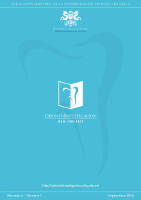Comparación in vitro de la efectividad en la obturación con el uso de dos sistemas de obturación: sistema ProFile Vortex y condensación lateral en frio, utilizando el estereoscopio
Main Article Content
Abstract
The aim of this study was to determine the highest percentage of gutta-percha-filled area (PGFA) in the apical third of root canals after filling with cold lateral condensation technique and gutta percha carrier system, Profile Vortex Endodontic Obturators (Dentsply Tulsa Dental, Tulsa, OK). Twenty-eight extracted human single root premolars with minimum curvature based on Schneider"™s technique, were prepared with ProFile Vortex rotatory files up to apical file 35, taper 0,06, and randomly divided into two groups of 14 teeth each for both obturation techniques. The teeth were sectioned horizontally at 5 mm from the apex and observed under a stereo microscope at 40x. The total cross-sectional area of each canal was measured and the areas of guttapercha were calculated and converted to percentages of total surface area using Photoshop CS5.1. Finally, data was subjected to the non-parametric Wilcoxon test. The results show that at 5 mm, the carrier system ProFile Vortex Endodontic Obturators (Dentsply Tulsa Dental, Tulsa, OK) produced significantly higher gutta-percha filled areas (p<0,05), and as a result exhibited a more complete obturation of the root canals compared to cold lateral condensation.
Article Details
References
Cohen S. Hargreaves K. Vías de la Pulpa. St.Louis, Mo: Mosby Elsevier; 201 1.
Gencoglu N. Orucoglu H. Helvacioglu D.Apical Leakage of Different Gutta-perchaTechniques: Thermafil, Js Quick-Fill, SoftCore, Microseal, System B and LateralCondensation with a Computerized FluidFiltration Meter. European Journal ofDentistry. 2007;1 (2):97-103.
Zarei M. Talati A. Mortazavi M. Zarch H.Javidi M. Bidokhty, H. In-vitro evaluation ofthe effect of canal curvature on adaptationof gutta-percha in Canals obturated withHEROfill System by CBCT. Journal of OralScience. 201 1 ;5(1 ):43-50.
Gutmann J. Saunders W. Saunders E. NguyenL. An assessment of the plastic Thermafilobturation technique Part 1 , Radiographicevaluation of adaptation and placement.InternationalEndodonticJournal.1 993;26(3):173-178.
Kontakiotis E. Chaniotis A. Georgopoulou M.Fluid filtration evaluation of 3 obturationtechniques. Quitessence International.2007;38(7):41 0-41 6.
De-Deus G. Gurgel-Filho ED. Magalhaes K.Coutinho-Filho T. A laboratory analysis ofgutta-percha-filled area obtained usingThermafil, SystemBandlateralcondensation. International EndodonticJournal. 2006;39(5):378-383.
Peng L. Ye L. Tan H. Outcome of root canalobturation y warm gutta-percha versus coldlateral condensation: a meta-analysis.Journal of Endodontic. 2007;33(2):1 06-1 09.
Collins J. Walker M. Kulild J. Lee C., AComparison of Three Gutta PerchaObturation Techniques to Replicate CanalIrregularities. Journal of Endodontics.2006;32(8):762-765.
García A. Navarro J. Obturación enendodoncia- Nuevos sistemas de obturación:revisióndeliteratura.RevistaEstomatológica Herediana. 201 1 ;21 (3):166-174.

